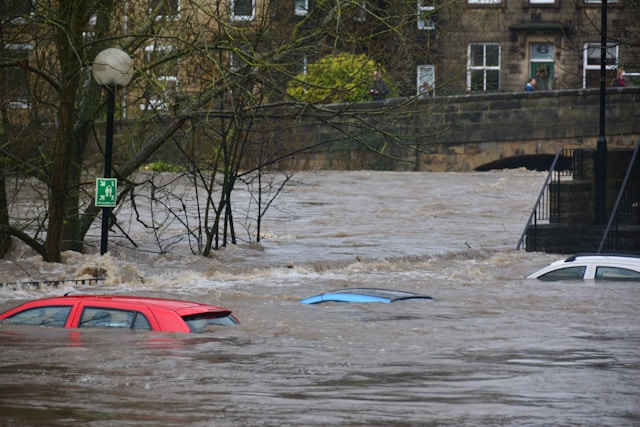
by Deep Green Resistance News Service | Mar 16, 2012 | Climate Change, NEWS
By Environment News Service
Nearly four million Americans are at risk of severe flooding as climate change raises sea levels and intensifies storm surges during the coming century, new research indicates.
Two studies, published today in the journal “Environmental Research Letters,” provide evidence that sea levels are rising, creating higher and higher floods that will inundate much of the low-lying coastal United States.
Ben Strauss, a researcher at the nonprofit Climate Central who co-authored both papers, said, “The sea level rise taking place right now is quickly making extreme coastal floods more common, increasing risk for millions of people where they live and work.”
“Sea level rise makes every single coastal storm flood higher,” said Strauss. “With so many communities concentrated on U.S. coasts, the odds for major damage get bigger every year.”
The first study, by researchers at Climate Central and the University of Arizona, finds that around 32,000 square kilometers (12,355 square miles) of U.S. land lies within one vertical meter of the high tide line.
This area encompasses about 2.1 million housing units where 3.9 million people live.
For this study, the researchers created a new model to identify the areas of the U.S. mainland that are at risk of flooding. With a predicted sea level rise of one meter (39 inches) or more by the end of the century, this study suggests that the U.S. government’s currently designated flood zones should not be considered stable.
This study demonstrates that coastal dwellings on every coast are exposed to this risk. At the state level, areas surrounding the Gulf of Mexico appear to be the most vulnerable. In terms of population, Florida is the most vulnerable, followed by Louisiana, California, New York and New Jersey.
The Los Angeles metropolitan area is of great concern, the researchers warn, citing previous studies suggesting that flooding may reach rare heights more swiftly in southern California than in any other U.S. mainland area.
Read more from Environment News Service:
Photo by Chris Gallagher on Unsplash
by Deep Green Resistance News Service | Mar 8, 2012 | Toxification
By Krishna Ramanujan
A new report has found dozens of cases of illness, death and reproductive issues in cows, horses, goats, llamas, chickens, dogs, cats, fish and other wildlife, and humans. It says these conditions could be the result of exposure to gas drilling operations.
Hydraulic fracturing, popularly called hydrofracking, is a process for extracting natural gas from shale using chemicals and water.
The paper’s authors, Robert Oswald, a professor of molecular medicine at Cornell’s College of Veterinary Medicine, and veterinarian Michelle Bamberger, DVM ’85, interviewed animal owners in six states — Colorado, Louisiana, New York, Ohio, Pennsylvania and Texas — and cited 24 cases where animals were potentially affected by gas drilling.
According to the study, recently published online and appearing soon in print, in New Solutions: A Journal of Environmental and Occupational Health Policy, making a direct link between death and illness is not possible due to incomplete testing, proprietary secrecy from gas drilling companies regarding the chemicals used in hydrofracking, and non-disclosure agreements that seal testimony and evidence when lawsuits are settled.
“We have a number of case studies — they don’t tell us about the prevalence of problems associated with hydraulic fracturing, but they do tell us how things can happen,” said Oswald.
Some of the case studies include:
- In Louisiana, 17 cows died within an hour of direct exposure to hydraulic fracturing fluid. A necropsy report listed respiratory failure with circulatory collapse as the most likely cause of death.
- A farmer separated his herd of cows into two groups: 60 were in a pasture with a creek where hydrofracking wastewater was allegedly dumped; 36 were in separate fields without creek access. Of the 60 cows exposed to the creek water, 21 died and 16 failed to produce calves the following spring. None of the 36 cows in separated fields had health problems, though one cow failed to breed in the spring.
- Another farmer reported that 140 of his cows were exposed to hydrofracking fluid when wastewater impoundment was allegedly slit, and the fluid drained into a pasture and a pond. “These farmers saw workers slitting the liner to decrease the amount of liquid in the impoundment in order to refill it,” said Bamberger. “We have heard it now on several occasions.” Of the 140 cows, about 70 died, and there were high incidences of stillborn and stunted calves.
The authors note that the “most striking finding” of their study was how difficult it was to get solid information on the link between hydrofracking and health effects.
To provide better assessments of health impacts, the researchers recommend:
- prohibiting nondisclosure agreements when public health is at stake;
- increasing food safety testing and research, as the study documented that animals exposed to chemicals were not tested prior to slaughter, and little is known about the effects of hydrofracking chemicals on meat and dairy products;
- improving the monitoring of routes of exposure, including in water, soil and air; and, most importantly,
- fully testing the air, water, soil and animals prior to drilling and at regular intervals after drilling is completed, and disclosing fully the chemicals used when hydrofracking.
“Without knowledge of all the chemicals being used, you can’t test before drilling,” said Bamberger. “And if we don’t have predrilling tests then if you find a chemical postdrilling, how can you prove that” it came from hydrofracking, she added.
From Physorg: http://www.physorg.com/news/2012-03-reproductive-problems-death-animals-exposed.html

